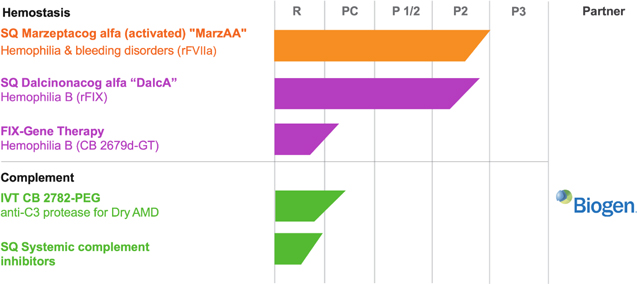| | • | | experience any delays or other issues with any of the above. |
In addition, in connection with the license granted to us by Pfizer, we agreed to make contingent cash payments to Pfizer Inc. (“Pfizer”) in an aggregate amount equal to up to $17.5 million, payable upon the achievement of clinical, regulatory and commercial milestones, the timing of which is uncertain. Following commercialization of any Factor VIIa products, Pfizer would also receive a single-digit royalty on net product sales on acountry-by-country basis for a predefined royalty term.
In connection with the license agreement with ISU Abxis (“ISU”), we will also make up to an aggregate of $19.5 million in milestone payments to ISU, inclusive of $2.5 million in regulatory and development milestone payment and up to $17 million in commercial milestone payment, if the applicable milestones are met.
In connection with our collaboration with Mosaic regarding our anti-complement program, we have agreed to pay Mosaic a double-digit percentage of funds we receive from Biogen or other sublicensees, or certain milestone payments and royalties if we develop and commercialize products from the collaboration our self.
Further, in connection with the development and manufacturing agreement that we have with AGC, we have firm work orders with AGC Biologics, Inc. (“AGC”) to manufacture MarzAA and DalcA to support our clinical trials. Furthermore, in connection with the clinical supply services agreement we have with Catalent Indiana, LLC (“Catalent”), we have firm work orders with Catalent to manufacture DalcA to support its clinical trial.
To become and remain profitable, we must succeed in developing and eventually commercializing products that generate significant revenue. This will require us to be successful in a range of challenging activities, including completing preclinical testing and clinical trials of product candidates, obtaining regulatory approval for these product candidates and manufacturing, marketing and selling any products for which regulatory approval is obtained. We are only in the preliminary stages of most of these activities. We may never succeed in these activities and, even if we do, we may never generate revenues that are significant enough to achieve profitability.
Because of the numerous risks and uncertainties associated with pharmaceutical product development, we are unable to accurately predict the timing or amount of increased expenses or when, or if, we will be able to achieve profitability. Even if we do achieve profitability, we may not be able to sustain or increase profitability on a quarterly or annual basis. Failure to become and remain profitable would depress the value of our common stock and could impair our ability to raise capital, expand our business, maintain research and development efforts, diversify product offerings or even continue operations. A decline in the value of our common stock could also cause you to lose all or part of your investment.
We may need additional capital. If we are unable to raise sufficient capital, we will be forced to delay, reduce or eliminate product development programs.
Developing pharmaceutical products, including conducting preclinical studies and clinical trials, is expensive. We expect our research and development expenses to increase with our ongoing activities, particularly activities related to the continued clinical development of MarzAA and DalcA, including clinical efficacy trials for each compound. We believe that our available cash will be sufficient to fund our operations for at least the next 12 months. However, we may need to raise substantial additional capital to complete the development and commercialization of MarzAA, DalcA, or other product candidates, and depending on the availability of capital, may need to delay development of some of our product candidates.
Until we can generate a sufficient revenue from our product candidates, if ever, we expect to finance future cash needs through public or private equity offerings, debt financings, corporate collaborations and/or licensing arrangements. Additional funds may not be available when we need them on terms that are acceptable, or at all. If adequate funds are not available, we may be required to delay, reduce the scope of or eliminate one or more of our research or development programs.
Because successful development of our product candidates is uncertain, we are unable to estimate the actual funds required to complete research and development and commercialize our products under development. Our future funding requirements, both near and long-term, will depend on many factors, including, but not limited to:
| | • | | the initiation, progress, timing, costs and results of clinical trials for our product candidates in hemophilia, including MarzAA and DalcA; |
| | • | | the number and characteristics of product candidates that we pursue; |
S-6

